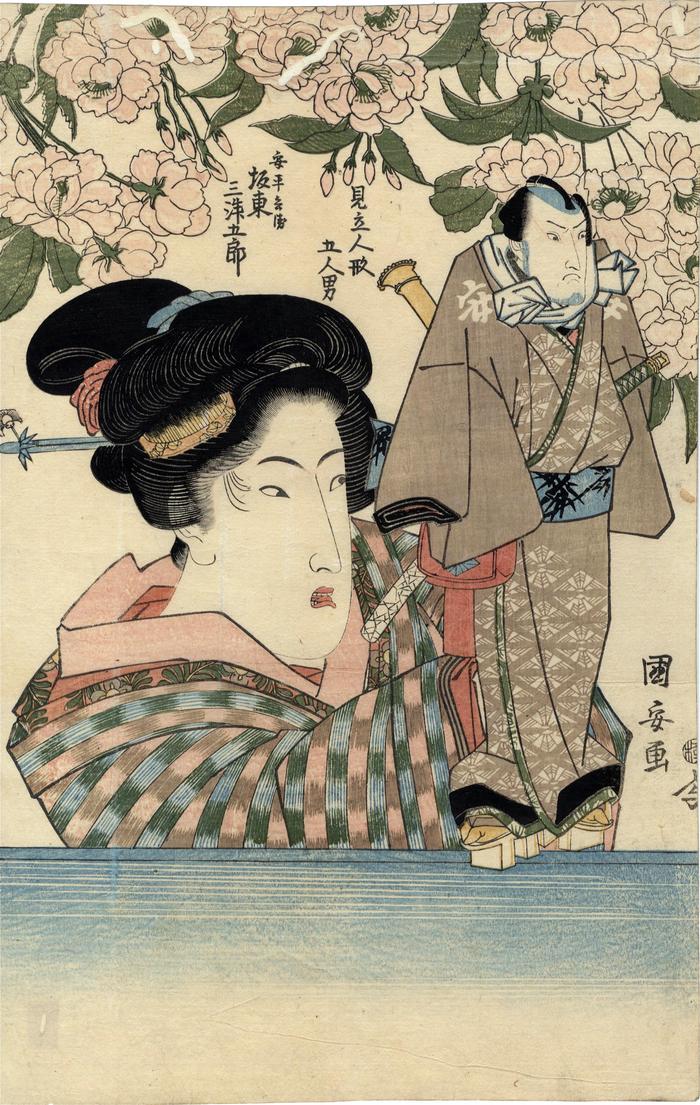Utagawa Kuniyasu (歌川国安) (artist 1794 – 1832)
The puppet the bijin is holding is in the form of Bandō Mitsugorō III (坂東三津五郎) as the otokodate An no Heibei (安ノ平兵衛) from the series 'Five Chivalrous Men as Puppets' (Mitate ningyō gonin otoko - 見立人形五人男)
ca 1827
9.5 in x 14.75 in (Overall dimensions) Japanese color woodblock print
Signed: Kuniyasu ga (国安画)
Publisher: Uemura Yohei (Marks 423 - seal 05-007)
Censor's seal: kiwame
Lyon Collection - set of all 5 prints The wonder and joy of discovery in what is actually being represented in traditional Japanese woodblock prints can be absolutely astounding. What appears here to be a beautiful woman manipulating a small puppet is actually so much more than meets the eye. The puppets is also a portrait of one of the most famous kabuki actors from the late 1820s, Bandō Mitsugorō III. Here he represents a famous rogue, An no Heibei. But who was An no Heibei? Now there is a story that needs telling.
There was once a real-life An no Heibei, but he was a genuine scoundrel. "At the end of the seventeenth century and beginning of the eighteenth, Karigane Bunshichi, Gokuin no Sen'emon, An no Heibei, Hote no Ichiemon, and Kaminari Shokuro haunted the streets of Osaka, robbing, beating, and even killing fellow residents. In the summer of 1701 the police caught up with the violent young men, and, after an investigation, authorities publicly executed them in the Eighth Month of the following year. The brazen personality of the ruffians and their contemptuous disregard for the law riveted the attention of Osakans, who began to create an intriguing set of myths about the motives and deeds of those ne'er-do-wells of Naniwa, a traditional name for Osaka. In time the condemned men were elevated to legendary status. Celebrated in ballads, plays, stories, and wood-block prints, the Five Men of Naniwa, thugs and murderers in real life, became transformed into protectors of ordinary people and the embodiment of the best and most noble aspirations and values espoused by the commoners of Osaka."
Quoted from: Osaka: The Merchants' Capital of Early Modern Japan in an essay by Gary Leupp, 'The Five Men of Naniwa: Gang Violence and Popular Culture in Genroku Osaka', pp. 125-26.
The real An no Heibei (ca. 1672-1702)
"In a gang with Kaitate no Kichiemon, Hote no Ichiemon, Mippiki Jihei and others as of the Seventh Month of 1697. Attacked people with a sword on the sixth day, Seventh Month, 1699, which he then secreted with Kichiemon. On the evening of the sixth day, Sixth Month, 1701, stabbed Kibei, employee of Kawachiya Gohei of the residential quarter Kyuhoji, in the side with a dagger. Subsequent police investigation resulted in Heibei's arrest the following day. Beheaded at the execution grounds located at Sennichi Mae on the twenty-sixth day of the Eighth Month, 1702." (Ibid., p. 134) (JSV)
****
The character 安 (an) appears on the robe of actor.
****
The otokodate frequently carried shakuhachi flutes both for playing and to as symbols of their authority because they often used them as weapons. In this image the 'puppet' is carrying it on his back and can be seen partially poking out near his right shoulder. (JSV)
beautiful woman picture (bijin-ga - 美人画) (genre)
actor prints (yakusha-e - 役者絵) (genre)
Uemura Yohei (上村与兵衛) (publisher)
Bandō Mitsugorō III (三代目坂東三津五郎: 11/1799 to 12/1831) (actor)
Otokodate - chivalrous men (男伊達) (genre)
mitate-e (見立て絵) (author)
